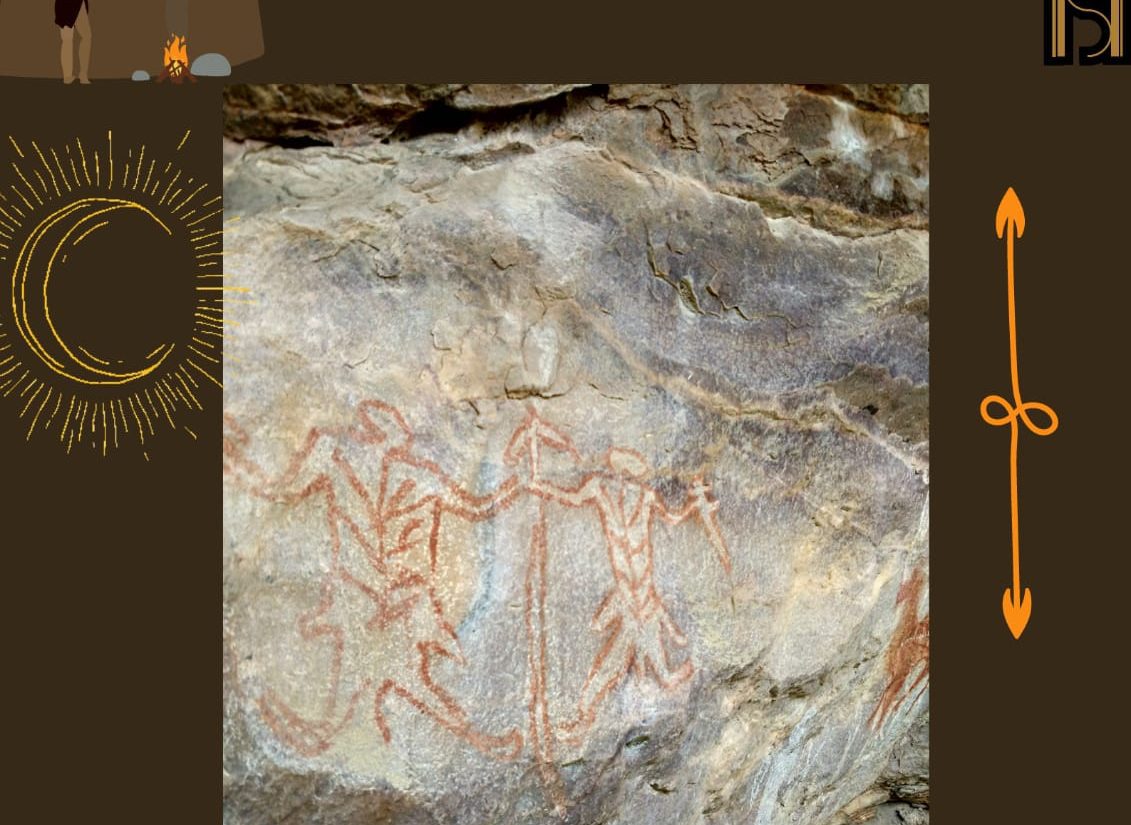Composite Imagery in Rock Art: A Sign Of Creativity
- iamanoushkajain
- December 9, 2021

Article By Subject Matter Expert
Dr Sonika Sandhu
Anthropomorphic images as rock art appear widely across the world right from Upper Palaeolithic till the Neolithic and even continued into Bronze age for some cultures. The range of rock art available in India is both wide and varied in terms of both style and theme. Remains of rock paintings were found on the walls of caves located in several districts of Madhya Pradesh, Uttar Pradesh, Andhra Pradesh, Telangana, Kerala, Uttarakhand, Bihar, and Karnataka. HoweverCentral India is the richest region of rock art within the subcontinent, with the highest concentration situated in the Kaimur hills, Satpura, and Vindhyas.Rock art in India is often likened to those found in southern Africa and Australia. Several paintings of Central India resemble the style of Neolithic paintings of Rhodesia, Eastern Spain, South Africa, and Australia. The paintings depict various themes of hunting, battles, dances, and different human and animal figures along with composite images.
Rock art studies have a long history in India with innumerable scholars contributing to the field. These studies can be traced right from 1856 when Henwood reported the first petroglyphs, in 1867-68 Carlylle began recording some of the pictographs. These explorations continued through the late nineteenth and early twentieth centuries and scholars kept on adding to the growing knowledge and database on rock art in India (Chakravarty and Bednarik 1997 ; Chakraverty 2003; Cockburn 1883 ; Fawcett 1892 ; Ghosh 1932 ). However the highlight discovery was the Bhimbetka; a large complex of painted rock shelter found by V. S. Wakankar in the 1957. It was after this find that the rock art research in India became a deliberate pursuit, and a number of researchers began more systematic and through programs of exploration and documentation.
To study rockart a variety of methodological techniques are employed. The earliest researchers tended to focus on describing the most elaborate and aesthetically pleasing aspects of rock art, but, as studies gradually became increasingly formalized, more scientific approaches were applied focussing on colour analysis, sizing, numerical calculations etc. One of the key problems in rock art imagery is the direct interpretation and its implication on the meaning of the art. Domestic fauna, scenes of hunting, dancing, pastoralism, and food production, as well as religious and military imagery, have provided a common means to investigate rock art imagery and undertake regional comparisons (e.g., Tiwari 2000 ), without attempting to understand why the rock art has been produced or what role it played. To solve this issue ethnographic parallels with modern tribal groups in India have been used by a number of scholars in order to interpret rock art, with varying depths of appreciation for the appropriate use of these analogies.
Rock Art & Creativity:
In 1960s Laming-Empaire (1962) and Leroi-Gourhan (1964) expounded on applying structuralism to cave art interpretation and proposing that the symbolic dimension has been brought centre stage in rock-art interpretation. Today it is quite straightforward to assert that “what most clearly distinguishes the human species from other life forms is our ability to use symbols” Bernstein puts it, in “the alienation of art from truth” (1992, p. 4; author’s emphasis)
To elaborate, most cognitive sciences today hypothesize that reality is what we perceive individually. Each of our realities hence is different from the other. This illusion is an evolutionary play to negate valuing and obscuring veridical perceptions. It is often found that any art contains subversive elements that defy status quo and its conventions. This defiance of status quo is not only limited to contemporary art but is seen through different ages and periods. This understanding is therefore also applicable to rock art. Rock art imagery could have also been a communication medium used to reach out more people in appealing form so that the idea could be better conveyed and hence more likely to be accepted. The artistic processes take advantage of the human need for escapism and also enhance our aesthetic appreciation. This kind of escapist ability possibly is the precursor for cultures and is the base for dynamic nature of human societies. As said by Harari (2014) “An entrapment belief system was advantageous because it provided humans with an adaptation that arguably has placed them in a favourable position, even if quite ephemeral considering the long run of Earth’s history, when compared with all contemporary species: the ability to cooperate flexibly in large numbers.”
Humans as a specie have two basic instincts which drives them: preservation of the individual and preservation of the species. To understand this from rock art point of view,
Preservation of the individual (and the social group) is inherent in images related to hunting or to animals (and, more rarely, fish) that are important food sources. Preservation of the species, which involves sex and fertility, nurturing and group protective behaviour, is inherent to many images, both overtly in pubic triangles and phallus-like objects and more covertly with images of rutting or combative animals. Unlike animals, and from an unknown stage in our evolutionary history, humans also became concerned about where we came from and what happens when we die. The third idea is what has guided and formed basis of many religions and cults. For example Shamanism is an important belief system in many hunter gatherer societies around the world. These societies differ in their culture, habits, language etc but if they follow shamanism they would believe in co-existence with forms of magic and healing. Realization and performing the experience would be different as each of these societies would have their own rituals and guidelines. It is believed that a shaman is able to induce a state of trance and is able to have an out of body experience. The shaman can communicate with spirits and may also inhabit the body of an animal and perceive himself in animal form or with an animal part(head). Scholars now believe that there are very strong indications and clues in the subject matter of some prehistoric art.
It is commonly agreed that a representation of a human body with an animal head suggests shamanism. Besides paintings some palaeolithic figurines of this type have been found called and are called therianthropes. Of note is that such figurines are carved into the deepest crevices and recesses in rock art caves, possibly to increase longevity as they would hold some sacred value. These therianthropes necessarily do not only represent supernatural beings but could be shamans. This interpretation has a sound basis as even today in Africa many societies use masks during rituals to ward of witches, divination, reincarnate ancestors. The mask wearer is driven to the point of ecstasy by the dance and subsumes his personality to that of the mask, which of itself has great authority. The link between this altered ecstatic state and rock art has been explored by many researchers. It has been proposed that the composite images seen in deep trance were later painted as if ‘projected’ onto the cave wall in a manner equivalent to theprojection of entopic images, and that altered states of consciousness were the link between the evolution of higher states of consciousness and the origin of art.
Of note is that human biology has not changed much since upper palaeolithic, if we attempt to think more openly and declutter our minds from our cultural baggage, we may see these images in a new light and possibly their meanings would fall more in sync with their creators and original first viewers.
References:
- Mark, J.T., Marion, B.B. and Hoffman, D.D., 2010. Natural selection and veridical perceptions. Journal of Theoretical Biology, 266(4), pp.504-515.
- Diamond, J.J., Becker, J.A., Arenson, C.A., Chambers, C.V. and Rosenthal, M.P., 2007. Development of a scale to measure adults’ perceptions of health: Preliminary findings. Journal of Community Psychology, 35(5), pp.557-561.
- Fernandes, A.B., 2018. The entrapment of art: Rock-art, order, subversion, creativity, meaning, and the appeal of illusive imagery. Open Archaeology, 4(1), pp.280-298.
- Francfort, H.P., Hamayon, R.N. and Bahn, P.G. eds., 2001. The concept of shamanism: Uses and abuses(Vol. 10). Budapest: AkadémiaiKiadó.
- Morriss‐Kay, G.M., 2010. The evolution of human artistic creativity. Journal of anatomy, 216(2), pp.158-176.



















